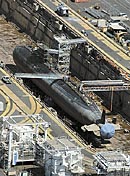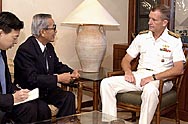 Sub's crew showed 'grave negligence,' Japan says Sub's crew showed 'grave negligence,' Japan says
 Greenville incident scripted into 'JAG' Greenville incident scripted into 'JAG'
 A Tribute to the Missing A Tribute to the Missing
 Previous stories Previous stories
 What do you think of the collision of the USS Greeneville and the Ehime Maru? Join our discussion board. What do you think of the collision of the USS Greeneville and the Ehime Maru? Join our discussion board.
By Mike Gordon, Dan Nakaso and David Waite
Advertiser Staff Writers
Although distracted by civilian guests aboard the USS Greeneville, a sailor plotting surface ships with pencil and paper still continued to update the submarine’s computer system so others would know if vessels were in the way during an emergency surfacing drill, a National Transportation Safety Board spokesman said yesterday.
 |
| Its propeller wrapped in blue tarp, the USS Greeneville yesterday sat at dry dock for repairs in Pearl Harbor.
Associated Press |
NTSB investigators do not know yet if the distraction contributed to the collision between the Greeneville and the Japanese fishing vessel Ehime Maru.
"He was still doing his job plotting," NTSB spokesman Ted Lopatkiewicz said yesterday. "It’s just that he stopped transferring this information to paper."
The accident has prompted the Navy to establish a court of inquiry, its highest form of administrative investigation. Originally scheduled to begin today and then delayed until Monday, Navy sources last night said it may not begin until early March because lawyers for one of the three officers under investigation are asking for more preparation time.
The Navy believes the Greeneville detected the Ehime Maru with its sonar equipment more than an hour before colliding with the fishing vessel at 1:43 p.m. Feb. 9 in waters nine miles south of Diamond Head. Nine of the 35 people aboard the Ehime Maru remain missing and are presumed dead.
What caused the Greeneville crew to lose track of the Ehime Maru and surface almost directly below it is the focus of the federal investigation.
The sailor doing the plotting aboard the submarine was the "fire control technician of the watch." Typically, he would receive an electronic feed from the sonar team of all surface contacts, then chart that information on a computer for wider distribution. He also would write it on paper as a backup for quick reference in the control room, the Navy said yesterday.
NTSB officials said Tuesday that the technician was not able to continue his manual plotting because he was distracted by some of the 16 visitors assembled in the control room.
If that was the case, retired Navy officers said, the technician should have raised objections.
"If the guy was distracted, he should have spoken up and said these guys are bothering me and I can’t do my work," said Jim Bush, a retired Navy captain who from Florida who commanded the ballistic-missile submarine USS Simon Bolivar.
Bush said the presence in the Greeneville control room of the chief of staff for the U.S. Pacific Fleet’s submarine force, Capt. Bob Brandhuber, could easily have intimidated the technician, however, especially in a room full of guests. Brandhuber served as the escort for the civilians.
Roy Johnson, a retired lieutenant commander who served aboard surface ships during 30 years in the Navy, noted that the plotting job would normally be done by a relatively young and inexperienced sailor, who might have been less prone to object to the distractions.
 |
| Adm. Dennis Blair, commander in chief of U.S. forces in the Pacific, talks with Moriyuki Kato, governor of Ehime prefecture.
U.S. Pacific Command photo via Associated Press |
"He should have yelled at the top of his lungs: ‘Stop, shut up,’ " said Johnson, who lives in Honolulu.
But that the Greeneville lost track of the Ehime Maru is "inexcusable," Johnson said.
"The sensitivity of the sonar once you have it, you don’t lose it," Johnson said. "It was making noise the entire time. They should never have lost it, no matter the target angle of the ship, they could still hear it."
The Greeneville was sailing that day without the aid of a monitor in the control room that instantly displays sonar contacts made in the sonar room, according to crew statements to the NTSB. Although investigators do not know its signficance, Johnson said that could have contributed to the accident.
"That information comes out to the officer of the deck and the officer of the deck should know about surface contacts," he said. "Did the captain forget? Maybe. But the officer of the deck shouldn’t have."
The job of fire control technician is important to the smooth operation of a submarine underway, said Michael Nahoopii, a Navy Academy graduate who was officer of the deck of the fast-attack submarine USS Indianapolis.
Keeping a pencil and paper record of sonar contacts is always done as a backup. It’s more "old school," a form of charting common for submariners who did not have the use of modern computers, he said.
"For me personlly, I liked the paper," Nahoopii said. "You make sure all the ships on the left of you are moving left, going away from you, and all the ships on the right are heading right."
Transmitting the information to other display screens in the control room, although common, is only as good as the training of the people watching them, he said.
"It may be visible and others can see it, but if you are not trained to interpret it, it doesn’t help you," he said.
The NTSB investigation into what caused the two ships to cross paths could take a year to complete. Among the 200 Navy documents requested by the safety board will be second-by-second data contained in a device aboard the Greeneville that is similar to an airplane’s black box.
Hammerschmidt said the information, which when printed out totaled 500 pages, was electronically sent to NTSB offices in Washington, D.C., by the Navy. "It was information we were very glad to know existed," he said.
Meanwhile yesterday:
 The Japan Maritime Self Defense Force designated Rear Adm. Isamu Ozawa to serve as an advisor to the court of inquiry investigating the collision, which will be presided over by three Navy admirals. Ozawa serves as the Defense Force’s chief of staff and commandant of the Maizuru District. He will not have a vote but will be included in the court’s deliberations and may submit questions to the members and counsel. The Japan Maritime Self Defense Force designated Rear Adm. Isamu Ozawa to serve as an advisor to the court of inquiry investigating the collision, which will be presided over by three Navy admirals. Ozawa serves as the Defense Force’s chief of staff and commandant of the Maizuru District. He will not have a vote but will be included in the court’s deliberations and may submit questions to the members and counsel.
Ozawa, 50, is a graduate of the National Defense Academy in Japan and the U.S. Naval War College in Newport, R.I. He joined the Maritime Self Defense Force in 1974 and served aboard submarines.
 NTSB investigators visited the Greeneville in dry dock, where it had its weapons off-loaded. Navy officials also have been inspecting the Greeneville’s rudder, propeller and hull to determine the extent of repairs following the collision with the Ehime Maru. NTSB investigators visited the Greeneville in dry dock, where it had its weapons off-loaded. Navy officials also have been inspecting the Greeneville’s rudder, propeller and hull to determine the extent of repairs following the collision with the Ehime Maru.
 Gov. Moriyuki Kato of Japan’s Ehime prefecture stressed the importance of raising the Ehime Maru to Adm. Dennis Blair, commander of U.S. Pacific Forces. Blair said that Japanese experts would be consulted as the Navy explores the feasibility of raising the ship. Gov. Moriyuki Kato of Japan’s Ehime prefecture stressed the importance of raising the Ehime Maru to Adm. Dennis Blair, commander of U.S. Pacific Forces. Blair said that Japanese experts would be consulted as the Navy explores the feasibility of raising the ship.
 Rick Fried, a Honolulu attorney who has sued the military more than 100 times, said he has been contacted by people in Japan who want to know the extent of damages the U.S. government might have to pay. Survivors and victims of the missing fishermen and crew "clearly have a cause of action," Fried said. They could theoretically win damages for loss of life, lost wages and emotional suffering, he said. But the Suits and Admiralty Act and the Public Vessels Act would prevent them from winning punitive damages, Fried said. Rick Fried, a Honolulu attorney who has sued the military more than 100 times, said he has been contacted by people in Japan who want to know the extent of damages the U.S. government might have to pay. Survivors and victims of the missing fishermen and crew "clearly have a cause of action," Fried said. They could theoretically win damages for loss of life, lost wages and emotional suffering, he said. But the Suits and Admiralty Act and the Public Vessels Act would prevent them from winning punitive damages, Fried said.
[back to top] |


